One of the largest building ever built by man. Rises to the sky for several thousand years in the Giza plateau in Egypt.
Her measurements are: the northern side of me 230 25.05 cm, 35.65 cm I 230 west side, east side of I 39.05 230 cm and finally the south side of I 45.35 230 cm, a height of 146 m. All this for a weight of about 6,000,000 tons and an 'area of \u200b\u200b13.1 acres. The base angles are almost perfect: southeast corner 56'e 89 ° 27 'north-east to 90 ° 3' 2 ", to the southwest 90 ° 0 '33", and the north-west 89 ° 59' 58 "(just two seconds' s frame difference).
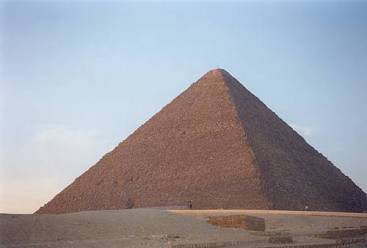
According to reliable estimates, the pyramid consists of a total of around 2,300,000 blocks of limestone and granite, with weights ranging from 2.5 tons to 70 tons. Not only that, but you must also add a coating similar to a mirror consisting of 22 acres, with 115,000 polished stones, each weighing 10 tonnes, which originally covered all four sides. After being separated by a violent earthquake in 1301 BC, most of the blocks lining was removed for the construction of Cairo.
Among specialists in Egyptian archeology, the consensus is that it was built as a tomb for the pharaoh of the Fourth Dynasty (2575 - 2467 BC) Khufu (aka Cheops). This review is based mainly on the discovery of hieroglyphics on the stones inside the pyramid resembling his seal, and the testimony of Herodotus, who saw the sights in the fifth century BC C. or more than 2000 years after they were built. Despite the fact that no body was ever found within its well-sealed rooms, Egyptologists persist in their theory, giving rise to a story about tens of thousands of slaves forced to work for dozens of years in the construction of a pile of stones on which to put the corpse of a man .
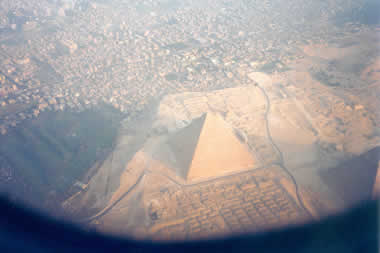
The Pyramid of Cheops (aerial)
The Chamber of Re: discovery all around ' year 820 AD by the Caliph Ma'mun. It is located one third of the Great Pyramid, that is about 45 m from the base. We expected to find a treasure in proportion to the greatness of the monarch, and the room instead of the Pharaoh (burial according to orthodox Egyptology) was completely empty and bare from any decoration and inscription. Only an empty granite sarcophagus (now the material is carved for his toughness and abrasive such as diamond powder or silicon carbide, carborundum said).
To access the King's Chamber, you have to overcome narrow streets and impractical, small corridors and galleries. The question that arises is how did the looters of graves to steal everything, absolutely everything in a room located about 45 m in height, and whose only way to get there is a tunnel from the base upward (blocked by heavy granite caps) that connects to the Great Gallery, a length of 46 m with a slope of 26 degrees.
| | Great Pyramid of Cheops: 2: unfinished underground chamber; 3: blind corridor; 4: ascending corridor; 5: horizontal corridor; 6: Queen's Chamber; 7: Grand Gallery; 8: tunnel dug by thieves; 9: room of the sarcophagus; 10: unloading bays; 11: Conduct of the King's Chamber ; 12: Behaviour of the queen's chamber. |
The measures of the Pyramid of Cheops
It 's the theory that aims to show how the Pyramid of Cheops was built on the basis of geometrical knowledge that made him a highly developed species of the world map. In the late second century BC, the grammarian greek Agatharchides of Cnidus, he discovered that the base of the Great Pyramid was just an eighth of a minute of one degree in length. From here you get that by multiplying the length by 8, then 60 and finally to 360, the result is remarkably close to the Earth's circumference.
In 1638 the Scottish mathematician John Greaves, during his visit to Egypt, took some measurements: the sarcophagus in the House of the King (1.97m), the height of the Pyramid (146.6m) and the base side (211.2m). The aim was to discover the unit of measurement used by the architects of Egypt, but unfortunately the readings were too low.
The next attempt was made by the team of French scientists led by Napoleon in Egypt. The team leader, Edme-François Jomard as Greaves intended to seek the unity of measurement, and then verify whether the measures could be due to the size of the Pyramid of the Earth.
Jomard measured one side of the base (230.9m) and height (146.6m), from which he could calculate in 51 º 19 'and the slope in the apotenusa 184.7m. He knew that the ancients indicated apotenusa in the first stage, and Herodotus wrote that a stadium was equal to 400 cubits, so that a cubit is equal to 0.4618m. Some Greek scholars had declared that the base of the pyramid was long cubiti.Moltiplicando 500 500 * 0.4618 Jomard got 230.9m ie The length of the base that was measured.
John Taylor in the early 1800s, he discovered that by dividing the perimeter by two times the height of the pyramid is obtained is very similar to the pi-greek, which indicates the constant ratio the circumference and its diameter. The pi-greek was calculated with accuracy up to the fourth decimal place only in the sixth century AD Through this discovery, Taylor calculated the ratio between the height and the perimeter as equal to the ratio between the polar radius Earth and its circumference: 2 pi-greek .
Taylor's findings influenced not just a Scotsman named Charles Piazzi Smith. Smith calculated the "pyramid inch" as 1 / 25 of a cubit. In 1864, Smith set out for Egypt. Calculated the position of the Pyramid at about 30 º north latitude. The shadow of the Pyramid disappeared completely at the spring equinox. His best fits the calculation of pi-greek until the fifth decimal place. The perimeter is inch pyramid was exactly 365.2 times 1000 (the number of days in the calendar year) and that at least 1,500 years before the Greeks first calculate the calendar, while the relationship between the lengths of the corridors of the pyramid revealed even some of the fateful date world history.
Furthermore, according to Smith, the pyramid also revealed the distance between the Sun and the Earth if its height in inches multiplied by 10 to the ninth power (10 to 9 was the relationship between the height and width of the Pyramid).
Joseph Seiss, an American clergyman, wrote that the stones of the pyramid contained a system of numbers that indicated measures, weights, angles, temperature, degrees, geometrical problems and cosmic measurements. Seiss was surprised by the recurring presence in his calculations of the number 5.
Other supporters of this theory emphasize that the meridian and parallel, intersecting in the Pyramid (30 º north latitude and 31 ° of longitude east) cross more land than any other as if the Egyptians want to place the Pyramid at the center of the inhabited world. A dial that extends north-west and north-east of the pyramid encapsulates the delta of the Nile. Petrie, to support this theory, he left for Egypt in 1880 with very reliable equipment. Petrie was amazed by the incredible precision with which the pyramid was built: both the length and slope errors were so minimal as to be imperceptible. The walls of the corridor down perfectly in their rights to 107m in length with 5mm un'approsimazione. Petrie confirmed the calculation of pi-greek discovering that the King's Chamber contained a pi-greek in the relationship between the length and perimeter.
Nowadays there are still scholars who believe in the significance of non-random size of the Pyramid of Cheops. The latest findings confirm what was said before. The pyramid inch (PI), whose discovery is attributed to Isaac Newton, is equal to 0.635660m, the pyramid is estimated at 25PI cubit from which it follows that the Chamber of King has a volume of one tonne or 12500PI pyramid. The angle of the pyramid is exactly 51 º, 51 'and 14.3''. The internal volume of the sarcophagus is equal to half the external volume. The exact location is 29 º 58 '51.06''and latitude and 31 º 9' of longitude. The Great Pyramid has no shadow at noon on the day of vernal equinox and looks toward the magnetic north with a variance of 3 'structure allowing it to be more carefully directed.
The parallel and the meridian that cover most of Earth's surface intersect in the Great Pyramid. The perimeter of the base divided by 100 'as the 365.24 days in a year like many other measures. The height (75cm 147m and although originally reached the probavilmente 150m) multiplied by one million is very close to the distance between Earth and the Sun The weight, estimated 5.955t, multiplied by a billion is a good approximation of the weight of Earth. The average height of the continents of the sea is almost exactly the height of the Pyramid. The four sides measure exactly: the north side of 230m and 25.05 cm, 45.35 cm and the south side 230m, 230m and 39.05 cm east side, west side 230m and 35.65 cm. And with maniacal precision its angle measured north-east 90 degrees, 3 'and 2'', south-east 89 º 56' and 27'', north-west 89 º 59 'and 58'', south-west 90 º and 33''. Finally, the curvature of the walls (the Pyramid of Cheops is the only one to have a slight curvature on the walls invisible to the naked eye) is identical to that of Earth. In conclusion, the Pyramid of Cheops, or Great Pyramid, is the scale 1:43.200 of the Earth.
Temple of Artemis
The location of the temple of Artemis among the seven wonders of the world is due to the wonderful architecture and the exceptional size of the whole. The oldest and most important building, known as "D" by archaeologists, was built by order of Croesus in about half of the seventh century of what we have as evidence of the inscriptions in Lidi and Greeks who were the pillars of the temple "D".
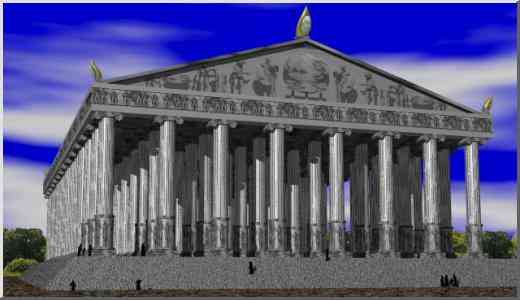
The work was carried out by the architect Chersiphron . The fame of the temple in ancient times was connected to the right of asylum that handed out and grew a lot for the stories related to famous people and the religious life of the city. Since ancient times the money needed for the maintenance of the temple was brought by pilgrims, merchants who thronged the temple and the priests who were selling the meat used for sacrifices. The excavations in the sanctuary today are still in progress, for the moment it is believed that in the seventh century, the shrine consisted of a structure similar to an altar changed several times and two other monuments: the ' Hekatompedon , so called because it measured 100 feet and the altar ramp. Everything was covered with the construction of the temple "D" and the courtyard of the altar. The temple "D" had eight columns on the front nine on the back and it seems, was not to be ipetro, although some scholars argue that the temple was open to the rain, because in the area of \u200b\u200bthe cell was found a pipe that was used to remove water.
 | Later it was thought that the coverage was cut off and limited to the colonnade, which is that the center was discovered. Access to the high terrace the sanctuary was done by means of marble steps built around the building as a giant frame. |
The high base 131 was off 7.85 m. along me Pliny says that the columns were 20 m tall, slender and elegantly fluted (Ionic), beautiful capitals of the supporting beams so large as to give rise to a legend about a goddess of the same intervention to help the architect to erect, these fact discouraged by the difficulties contemplating suicide. The frieze figures had not only a big notch on the molding that held the highest gable. The latter had three openings or windows that provided the central branch and beside him stood two statues of Amazons. Pliny speaks in the complex of 127 columns. The cell was located exactly in the center of the building, you are not sure of the fact that the statue of the goddess dominate the cell, but we can imagine that the size of the statue was that of Roman copies. The statue of the many strange breasts dell'Artemide Ephesia represents a mother goddess. The statue is stiff, the lower part looks like the sarcophagus of an Egyptian mummy.
decorative elements such as deer, lions, griffins, sphinxes, sirens and bees are from the East. The statues were very important in this complex, because of all the competitions held among the Greeks, including sculpture, which took place in Fifth century to adorn the temple was unique in many respects. The sculptors of bronze statues of the Amazons, but here shown in an attitude of supplicants begging refuge in the temple, were invited to exhibit them in public, and judged the four best (were those of Phidias, Policleto, cresyl and Fradmone) were chosen to decorate Temple "D" and the celebration of the Peace of Callias of 450 BC was the occasion for this event. The altar was not in a straight line from the center of the facade, but the priest could see the tops of the temple where it was "the appearance" of the goddess from the central window of the temple. To determine which was the cult image in ancient times is important to note that the temple "E" is intentionally similar in the lines and details in the temple "D".
Temple "D" was destroyed on July 21 of the 356 BC by a certain Erostato , which burned in this way of thinking to make his name immortal. In the lower level of excavations in what is called "filing of the foundation," dating from around 600 BC, were found statues of gold, wood, ivory, clay, some of them were depictions of Artemis as huntress goddess with a bow or goddess of Hades with a torch, the smallest archaic figures of the sixth century show various aspects of the goddess. Xenophon tells of seeing a statue in the temple archaic the same shape as those found in the excavations. These statues show a mixture of oriental forms, Lidie, Persian, Egyptian and Hittite. An important part of the rebuilding of the temple is represented by coins bearing his image, in the foundations of the temple "D" have been found 87 of the oldest known coins. To rebuild the facade of the sanctuary used a single currency and it was realized that the money had been a summary of the exact number of columns (8), as derived from other coins. After the destruction by the Goths, which took place in 262 AD, had tried to rebuild the temple in the classical period could be regarded as the expression of the spirit of Ionian Greece. Use in the fourth century the building was poorly tolerated by the Christian religion, and this was completely destroyed by S. John Chrysostom. It is said that people still continue to worship the stone taken away to the sacred, the very first and most revered stone had fallen from the sky, probably a meteorite. The discovery of the remains of the temple took place in 1860 by John Turtle Wood.
Lighthouse of Alexandria
Alexander the Great came to Egypt in 332 BC, after conquering the country quickly, he founded the new city to the west of the Nile delta, on a sandy strip of land that separates the swamp Mareotide from Medirerraneo, opposite the island of Faro. The project was handed to Dinocrates , he completed the Lake son of Ptolemy, first satrap, then king of Egypt.
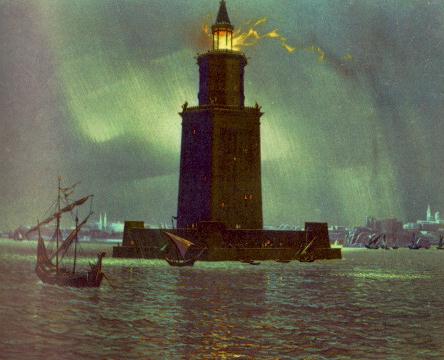
The island of Faro, on which arose the famous light tower was joined to the city with a seven-stage dam long (1290 meters), thus forming two ports communicating with the Nile through canals waterways. Already in ancient times had to be the use of light on the hill, near the Lido, fires because they were driving to mariners.
It is believed, however, that the first real tower-lighthouse, the one that gave all the other the name and model, has been to Alexandria. Architect he was Sostratus of Cnidus , Dexifane son, who worked under the first two Ptolemies. The construction of the lighthouse began probably in 297 BC, although in a later period the chronicler Eusebius, bishop of Caesarea, who had been imprisoned in Egypt, mentions in his chronicle the construction of the lighthouse in the year 283 or 282 BC. The inauguration took place under the second Ptolemy Philadelphus, between 280 and 279 BC. The lighthouse was dedicated to the sailors of the rescuers (" teois soteroi uper ton laixomenon ," as the epigraph dedication, which could easily be seen by anyone entering or coming out of the harbor), where you should probably recognize rather than Ptolemy I and Berenice, the Dioscuri, Castor and Pollux, the god of light, shining, that the sailors saw during the storm , perched on top of the mainmast: the flame of the lighthouse and isolated view high above the horizon, like a star, it seemed to them the appearance of the protective deity. Very soon spread throughout the ancient world, the fame of the light tower on the beach sort of Egypt, the tower was actually considered one of the most monumental buildings of the Greek kings.
| | do not know anything positive about the origin of the word "Faros" that some would derive from the Egyptian phaar "canvas" (the Greeks have named Pharos island where they were to buy phaar), but it is assumptions not consistent, especially since so far there was not even certain proof that the tiny island was the site of a major trade before the foundation of Alexandria. was mentioned in Homer's Odyssey Pharos the situation as an island and a day's sail from Egypt. The sources of Homer were obviously quite uncertain. The legend told the story of the beautiful Elena arrived in Egypt with Paris, but the island where there was nothing to see, and whose only inhabitants were the seals the bore. Ten years later they returned, this time accompanied by her husband Menelaus, who was returning home from Troy, who, driven off course by a storm, had landed on the ground. Menelaus - the legend goes, he met an old man and asked, "What is this island?". |
The old man replied that the island was the Pharaoh. Menelaus, who had not understood correctly, he asked again: "I will?". To which the old man replied in the affirmative, saying the word "Pharaoh" with the ancient Egyptian ruling, which transformed it into "Prouti. Menelaus played ill answer this time he understood "Proteus", a name he knew was that of the sea goddess that Poseidon had given the gift of prophecy. Thus the pronunciation of an old and obscure the misunderstandings of Menelaus made known to the world under the name of the island of Pharos, land protected by the god Proteus. Moreover, back in Greece, Menelaus added some embroidery to history, so that the seals, despised by Helen, turned into nymphs thronging the beach. Little is known around the building, admired by the older generation to never sufficiently explained, and as all the many lighthouses that took him as a model have been destroyed, if we except the little lighthouse Taposiris Magna 17 meters high, still surviving at about 40 km on the west coast of the Delta, for farcene idea we have to resort to the small lanterns, terracotta, mosaics, including one recently discovered at Jerash and Alexandrian coins minted under Domitian, Trajan, Hadrian, Antoninus Pius, Marcus Aurelius and Commodus . In the latter the essential details of the building are evident, especially Triton, we know that the sea monsters in graves or in spiral shells, as reproduced in Angles of the top of the first floor.
At the base is shown the door and a picture of Zeus Soter standing upright and holds a long scepter is clearly visible on several specimens. In addition, descriptions of Faro resort in the writings of various classical authors at the beginning of the Christian era, especially in Diodorus Siculus, Strabo and in Pliny the Elder, who tells us that the tower cost 800 talents, about 5 billion and 200 million lire. We are also unaware about the organization and administration of the Ptolemaic age, although he had no doubt of great importance for the economic life of the city. Under Roman rule, and Isis had, among a thousand others, even the epithet Faria and a temple of this goddess of navigation on the island was built at the foot of the great tower. The guard and the maintenance of the lighthouse, in the Roman age, were in charge of imperial freedmen. The lighting system was nell'accendere resinous wood fires and large torches, burn or in mineral oil in large containers. The potential and effectiveness of the light, which the ancients considered drugs, so great was the distance, about 50 km, which was projected, were increased intermittently by huge concave mirrors of metal, which were specifically invented by Archimedes. It 'a known fact that in the Middle Ages the city sent the Lighthouse of Alexandria gravure messages from incoming ships. The tower stood at the entrance of "megas limen", over a reunited island to the north-east of the island of Faro, in the place currently occupied by the ruined strong Qait Bey (1477-79), which covers foundations and the last vestiges. According to historical records, it was a real giant, as tall as a 45-story building. His height was in fact be around 120 to 130 meters and, like a wedding cake, was composed of three distinct levels, more and more narrow. The The 60 meter high, had a square plan and was very wide. The II was 30 meters high and, again according to stories and writings of ancient times, a very pointed octagonal tower. The last piece, 15 feet, instead consisted of a real cylindrical tower topped by a huge statue, probably that of Alexander the Great or one of Zeus Soter. The entrance to the monument was not at ground level, but a little raised at the end of a flight of steps. We know that the lighthouse across different historical periods and no major injuries shortly after the year 1000 was still standing. But later, the occupants Muslims destroyed the 3 rd floor of the lighthouse and replaced it with a small mosque. In days that followed, the lighthouse fell into disrepair, until it becomes a real "quarry" for the construction of the fort, cited above, which still stands. The Lighthouse of Alexandria is modeled similar to other towers, built in the Hellenistic and Roman times, in various parts of the Mediterranean: they generally had a lower height, were divided into a greater or lesser number of plans, but the type remains the same. The last possible depiction of the lighthouse before the Its destruction is found in a mosaic of the vault of the chapel of San Zeno in S. Marco in Venice, dating back to 1200. View the lighthouse and a ship with the Evangelist at the helm, and arrives in Alexandria to found the Christian Coptic Church in Egypt. Lighthouse at Alexandria's memory is kept alive by a modern sculpture in white marble which reproduces it with Isis Faria, and welcomes tourists who come to visit gardens in the catacombs of Kom-es-Shafur. Finally we must say that now maybe we can finally review a copy of this incredible monument, which could happen if it is kicked off a project of the Egyptian government for its reconstruction. With a little puzzle to be clarified: how will reconcile the original shape of the lighthouse, including a statue, a depiction that is human, with the Koran, at least theoretically forbids it.
Mausoleum of Halicarnassus
The term mausoleum which means the monumental tomb, descends from the tomb of Mausolus , satrap of Caria , at Halicarnassus. According to ancient authors is to Artemisia who was responsible for the construction of the mausoleum dedicated to his brother-husband Mausolus, and that is why it is often traced back to the dating two years elapsed between his death and hers , ie 353-351 BC.
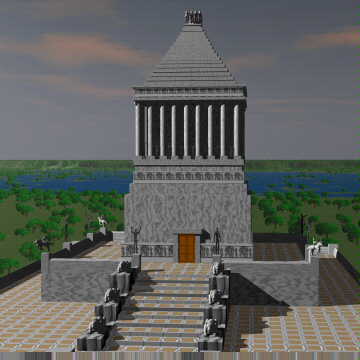 | | But it is clear that the tomb had proportions too large because in such a short time if he were able to design the project and complete the construction, it is more likely that this happened while he was Mausolus still-life, 370-365 BC, and that the execution completed around 350 BC, shortly after the death of Artemisia. The beauty of the tomb, together with the sculptural decoration, they qualify among the Seven Wonders of the Ancient World. Whence it came to call the name of any mausoleum monumental tomb (mausoleum of Augustus, Mausoleum Adriano). |
| But the tomb was essentially a classic architectural type: it would be inaccurate to call mausoleum buildings arose after the end of paganism. | 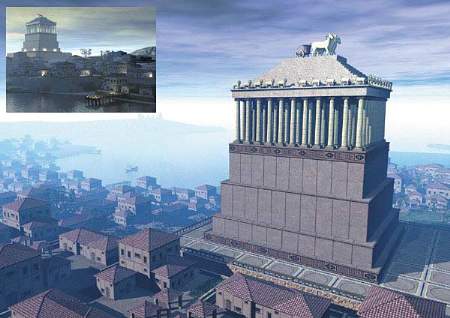 |
Mausolus's grave, according to the reconstruction of Krischen, has a large base of 22 meters in height, surrounded below by a sloping plinth, above which rises a colonnade of Ionic columns for nine eleven, about thirteen feet high, above this was a step pyramid of 7 meters and then the chariot.
All this reached a height of 49 meters. In this reconstruction the whole is linked by a very simple system based on multiple measures of foot and cubit Sami, joined by the ratio of two or three for two and multiple powers of two, according to consistent rules of Greek architecture.
Rebuilding Krischen was among many, the most simple and reliable. It agrees with the measurements of foundations and those parts were found by British architectural
Statue of Zeus
Throne about fourteen meters tall with back straight, culminating with figures of gods arms supported by sphinxes; God was sitting with draped tunic, which was of gold; feet resting on a stool worked, chiseled and resting on a lion in the round; work boots with engraved scenes of wars in his right hand holding a victory, which was said to have gold and measuring two meters ...
| with your left hand holding a pole resting on the ground very long and with a golden eagle on top, the face of God's goodness and expressing joy, as Chrysostom says. The head is crowned with olive trees. The face and body were bared ivory chiselled, while they were gold and other precious metals beard and hair. Gems scattered wherever appropriate, such as eyes. Can tell us something in this regard, the statues of the Bronze Statues. Pausanias describes minutely the large number of figures that are in the foot of the throne and around it on the basis, it comes even to twenty figures of attending the genesis of Pandora. All this rested on a foundation of Parian marble, the top one or two meters. When you think that the statue of Minerva in the Parthenon, was visible to the sailors who went head Sounion, like a lighthouse ideal, you have an idea of \u200b\u200bthe grandeur of the monuments that Fidia handed down to posterity. | |
would be easy to say that the "Bronze Warriors", as School fidiaca could give us an idea of \u200b\u200bthe grandeur of the artistic conception of the great Phidias, but we are not certain either that they came from that school, nor, if so, was, enough to give us a definition of the greatest artist of his "Zeus Olimpia ". We have very few sources, no image of the "Zeus" and a few vague descriptions, like the one that tells us that it was over forty feet high.
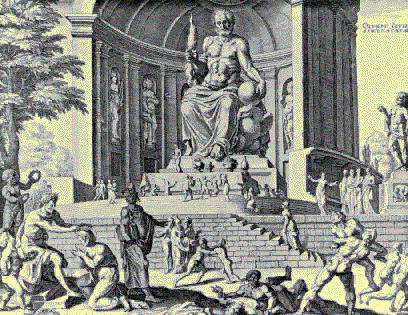
says Pausanias (Book V, 11, 1-10):
The God, built of gold and ivory is seated on a throne, a crown, which mimics the branches of olive trees, is on the head. He brings in his right hand a Victory, also of ivory and gold, holding a tapeworm and wears a crown on his head. In the left hand of god is a scepter adorned with all kinds of metals. The bird, which is placed atop the scepter is the eagle. Gold is also the shoes of God and so is the mantle, the mantle are placed as decoration, small figures and flowers of lily. The throne is variously adorned with gold and precious stones and also of ebony and ivory, and in it there are figures represented in paintings and carved figures. In each leg of the throne are four wins, which represent the pattern of the dancers, there are other two at the base of each leg. Above each of the front legs are children abducted by the Theban Sphinx, and, under the Sphinx, Apollo and Artemis dart Niobe's children. Between the legs of the throne are four bars, each of which cross from one leg. On the front bar (the one that is just opposite the entrance) there are seven statues, the eighth has no knowledge of how it is gone. Over the remaining bars shows the row fighter with Heracles against the Amazons, the number of these and the collection is twenty-nine.
Theseus is also among the companions of Heracles. But not only the legs supporting the throne, but also equal columns and placed between them. You can not go under the throne, as well as Amyclae us penetrate inside. In Olympia are prevented from attending certain barriers like a wall .......
In the highest part of the throne and a greater height of the head of the statue, Phidias did, on the one hand, the Charites and, secondly, the Hours, the one and the other three in number. The stool placed under the feet of Zeus, called "thranion" by the inhabitants of Attica, has golden lions, and, carved in relief, the battle of Theseus against the Amazons, the first feat of the Athenians against foreigners. To get an idea of \u200b\u200bthis statue have recourse to the currencies in which other artists were more or less evil, reproduced the portrait, and so include some coins of Elis at the time of Hadrian, there is a mural painting discovered at Eleusis. We know that Hadrian ordered a small-scale reproduction, in gold, perhaps to put it in his villa at Tivoli and, in turn, was reproduced on coins.
It discusses the "arms of the throne," because it is assumed that they were supported by sphinxes, there were two golden lions in the round, and no relief in short, there would be much to say, but the grandeur and the supreme beauty of this statue always eludes us, and we are condemned to guess the mystery as it wont make certain entities believed but never seen by human eyes, in true reality and photographed.
Colossus of Rhodes
one sacred law from Cyrene appears that the word "Kolossos" meant the non-iconic statue of clay, wood or wax represents twice by an individual, male or female. The word belongs to a pre-Greek language of the Asian strain, it means, even in pre-Hellenic age, not only the statue of magical value, but the real statue, with that meaning, it was acquired by the Doric dialect, when Dori colonized the islands and Asia Minor. For this reason we find this term attributed to the gigantic statue of Helios the Doric city of Rhodes erected in memory of the victorious resistance to the siege of Demetrius Poliorcetes.
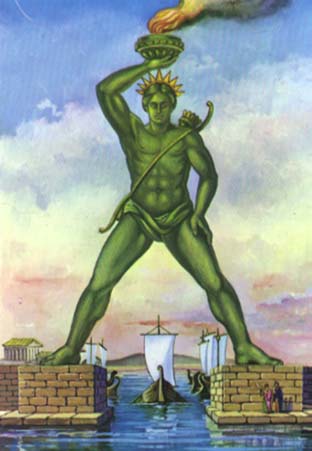 | | The statue was built by Chares of Lindos , a pupil of Lysippos. After it was built the word "Kolossos" indicates only the statues of very large and it was counted among the seven wonders of the world. The inscription is preserved in written sources and maybe we can reconstruct the epigram of the artist. The construction work lasted for twelve years, so that you can think that the work was dedicated in 290 BC Helios. It seems that it was elevated under Seleucus Nicator, a date that does not move the history. From the story of Philo Byzantium on the construction of the statue, we learn that it was 32 meters high and that the artist, having driven solidly with big feet iron pins a bronze statue of a marble base, raised the rest of the body in layers taking care to prepare the interior of the statue, a casing of iron, formed by horizontal bars and uprights, which follows the shape of the statue and were fixed with pins to the sides of it. |
The skeleton of iron was stabilized by a filling made from stone blocks. For the merger, on-site, parts bronze was all around a high embankment. It is possible that it was wooden and the number of axles and beams needed to be taken by the huge tower of siege, the Elepoli, 40 meters high, which is used by Demetrius Poliorcetes.
| In the years 224 and 223 BC, the Colossus of Rhodes fell after an earthquake, breaking his knees. According to Strabo was not restored to a sacred prohibition. The pieces were still lying on the ground in 653 AD by the Arabs were stolen during a raid and sold them to a jew of Emesa. During the rule of the Knights of Rhodes and the Renaissance, was born the legend arose that the Colossus of Rhodes in the port of Rhodes and the smaller ships to pass under the legs of the statue, reconstruction is not acceptable for stylistic and technical considerations. The better the idea of \u200b\u200bGabriel (that) the Colossus of Rhodes today where this becomes the "fortress of San Nicola, built by the Knights Hospitallers. | 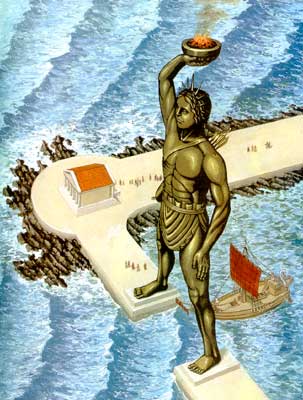 |
Hanging Gardens
All ancient texts say that the Hanging Gardens of Babylon were the only place in the city where the stone had been used. Herodotus, who liked the details very imaginative, devotes a long paragraph to the latter, that houses numbered among the seven wonders of the world. After a careful study of ancient texts and a very careful excavation, Robert Koldewey (an archaeologist) came inevitably to the conclusion that the structures in time at the Ishtar Gate were really the support base of the famous Hanging Gardens of Babylon.
| The processional road, 22 meters wide, covered with blue glazed tiles and decorated with 120 yards over two lions with gaping jaws and painted white, red and yellow, passing through the famous door Ishtar , huge fortification, flanked by two towers advanced, also entirely covered with blue glazed tiles decorated with images of animals sacred bulls, dragons, arranged in alternate, who are estimated to amount to thirty. | 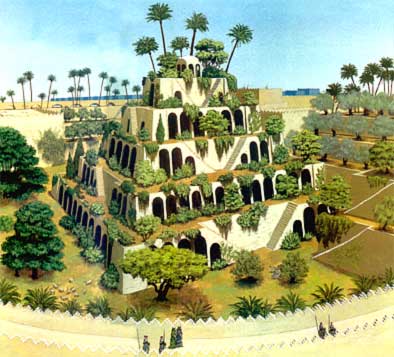 |
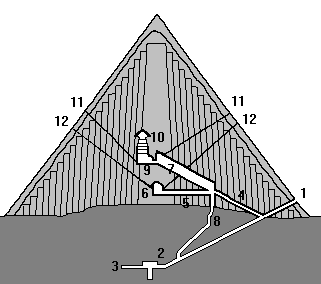
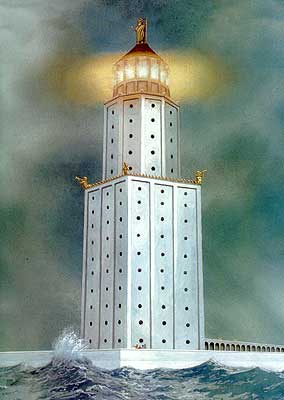
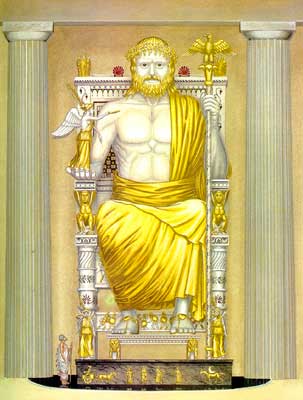
0 comments:
Post a Comment